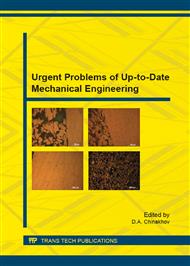p.99
p.104
p.108
p.114
p.121
p.126
p.130
p.137
p.144
New Technologies of Anodizing Components of Oil and Gas Industry Equipment Made of Aluminum Alloys
Abstract:
The injection of ozone into the air mixture for a barbotage of electrolyte at anodization of an aluminum alloy D16 in 5 % aqueous solution of sulfuric acid increases final thickness of oxide coating by 45 - 53 %, and simultaneous ultrasonic affecting and bubbling of electrolyte by the ozone-aerial mixture - only on 30 - 35 %, however in the latter case microhardness and wear resistance of coating increase. The additional applying of vibration decreases thickness, microhardness and wear resistance of an oxide layer.
Info:
Periodical:
Pages:
121-125
Citation:
Online since:
June 2015
Authors:
Keywords:
Price:
Сopyright:
© 2015 Trans Tech Publications Ltd. All Rights Reserved
Share:
Citation:


